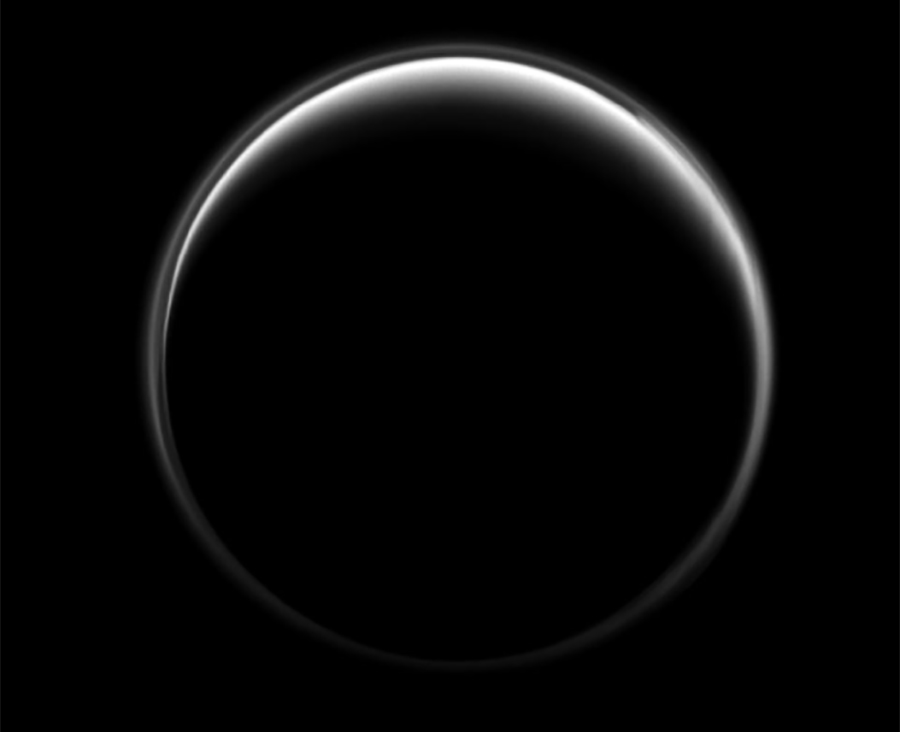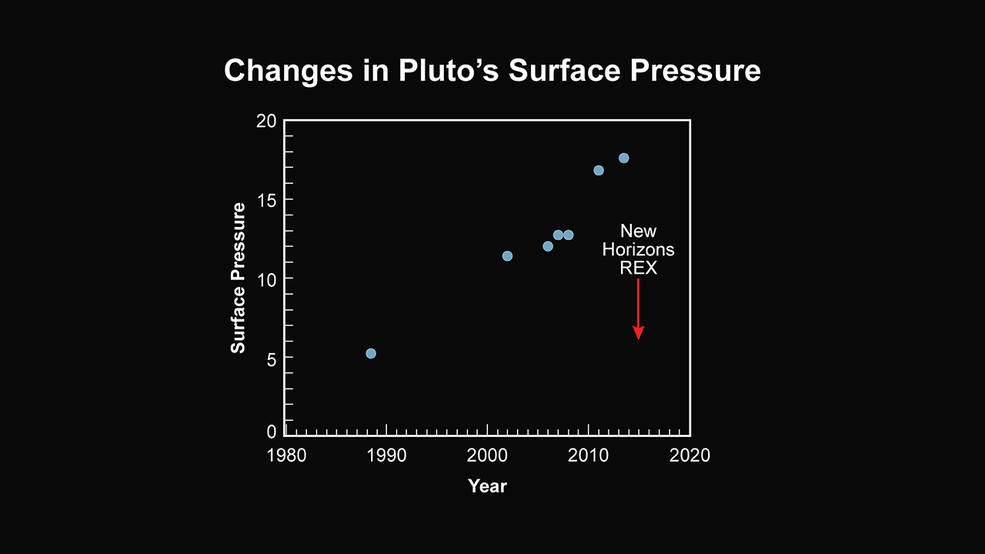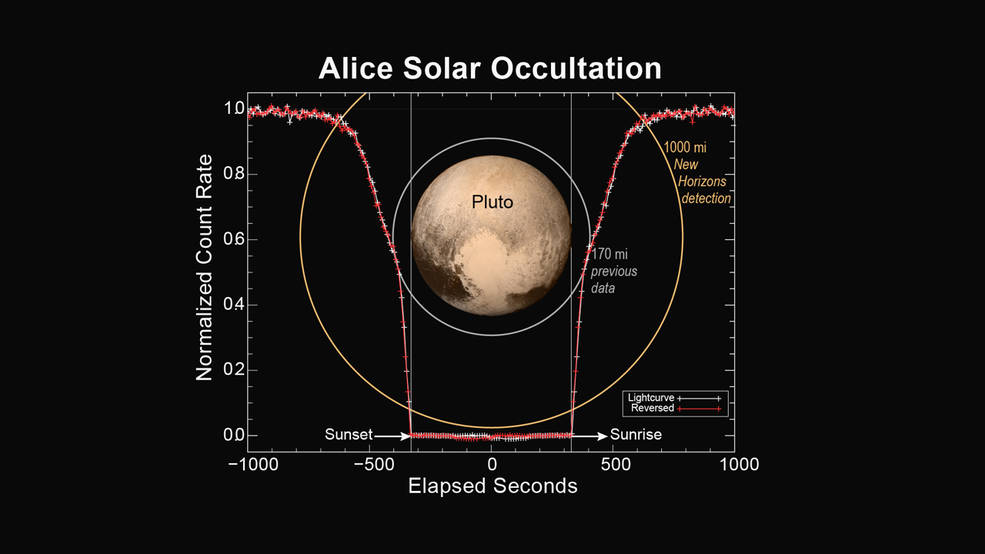New Horizons Sheds Light on Pluto’s Hazy Atmosphere
by Sophia Nasr, @Pharaoness

At a media briefing on July 24th, the New Horizons science team unveiled a breathtaking image that shows a haunting halo-like ring enveloping the silhouette of Pluto. This dramatic portrait was taken on July 15, after closest approach, when the New Horizons spacecraft was behind Pluto and its atmosphere backlit by the Sun. "This is our equivalent on New Horizons of the ‘Apollo Earthrise’ photograph that proves we were there. You can only get this image by going to Pluto and crossing to the far side and looking back," said Alan Stern, New Horizons Principal Investigator, Southwest Research Institute, Boulder, Colorado.
The image is reminiscent of a portrait of Titan taken in 2010 by the Cassini spacecraft.

First Photographic Evidence of Pluto’s Atmosphere
The existence of an atmosphere on Pluto was theorized for years but it wasn't until 1988 that scientists first detected an atmosphere on the dwarf planet during a stellar occultation. In a stellar occultation, a body such as a planet passes in front of a relatively bright star. A light curve graph is created by measuring the gradual dimming of starlight during such an event. If an atmosphere on Pluto were not present, starlight would blink instantly off and then back on again at the end of the occultation. However, for a short time at the start and end of the occultation, Pluto's atmosphere was backlit by the star, and the starlight dimmed more gradually. By modeling how the atmosphere refracted, or bent, the starlight, researchers detected that Pluto has a thin layer of atmosphere made of gaseous forms of the ices that cover its surface.
What makes the image of Pluto backlit by the Sun so remarkable, is that it is the first time we have photographic proof of an atmosphere around Pluto. "This is our first picture. This is the first time we’ve really seen it. This was the image that almost brought tears to the eyes of the atmospheric scientists on the team," said Michael Summers, New Horizons Co-Investigator, George Mason University, Fairfax, Virginia. Summers was one of the scientists on the New Horizons team, along with Alan Stern, who contributed to my article on Pluto’s atmosphere, written before the flyby of Pluto on July 14.
Extended Haze In Pluto’s Atmosphere
Seven hours after closest approach, the Long Range Reconnaissance Imager (LORRI) looked back at Pluto and captured the Sun’s light being scattered by the particles in Pluto’s atmosphere. This observation revealed that Pluto has a vast layer of haze extending out to as high as 160 kilometers (100 miles) above Pluto’s surface. This is five times higher than previous models had predicted. "Models predicted that haze particles would form low in the atmosphere, where the temperatures are cold[er], but it’s forming higher in the atmosphere where the temperatures are [warmer]," said Summers.

Look closely at the crescent in the image above—you can actually see the layers in Pluto’s atmosphere. That's phenomenal, to actually see the structure in Pluto's atmosphere as it is illuminated by the Sun.
The preliminary data shows two distinct layers of haze at 50 km (31 miles), and 84 km (52 miles) above Pluto’s surface. Understanding what is happening in Pluto’s atmosphere will help us figure out what is happening on its surface.
"The hazes detected in this image are a key element in creating the complex hydrocarbon compounds that give Pluto’s surface its reddish hue," said Michael Summers, New Horizons co-investigator at George Mason University in Fairfax, Virginia.
The haze is thought to form when methane gas particles (simple hydrocarbons) in the upper atmosphere of Pluto are broken apart by UV radiation from the Sun into radical chemical components. These radicals generate chemical reactions that lead to the formation of "complex hydrocarbons", like acetylene and ethylene. "As time goes on, these build up, they become supersaturated, and they should nucleate to form haze particles, which then grow, and eventually they will get big enough so that you’ll see a haze layer, and they will fall to the ground," explained Summers. This process also leads to the creation of tholins, which are hydrocarbons that have been altered by radiation from the Sun, and have a reddish hue. These tholins are likely the constituents that give Pluto’s surface its reddish color. There are still many mysteries that the team will be working to unfold in the coming weeks when more data comes in.
Previous models indicated it would be too warm for hazes to form at altitudes higher than 30 kilometers (20 miles) above Pluto’s surface.
"We don’t understand why there’s a haze layer up to 100 miles altitude. It really is a mystery," said Summers. "We’re going to need some new ideas to figure out what’s going on."
Dramatic and Rapid Decrease In Pluto’s Surface Pressure
A surprise discovery was revealed about Pluto’s surface pressure. "In a planetary atmosphere, the surface pressure, at any level, is the measure of the weight of the air above that level. And weight is gravity acting on mass. So if you know the surface pressure of a planet’s atmosphere, you can get a pretty good estimate of the total mass of that atmosphere," Summers explains. "It’s important because that’s a way of quantifying the global state of an atmosphere."
The following data plot shows the changes of Pluto’s surface pressure as a function of time.

Earth-based observations of Pluto’s surface pressure indicate that surface pressure has been increasing since Pluto was closest to the Sun in 1989—that is, as Pluto moved away from the Sun in its elliptical orbit and got cooler, the pressure increased. This is actually contrary to what’s expected. The expectation was that Pluto’s nitrogen atmosphere should condense and fall closer to Pluto’s surface as the dwarf planet recedes from the Sun.
The surprise in this story was provided by data taken with the Radio Science Experiment (REX) on New Horizons. This newest data point shows that Pluto’s surface pressure has decreased significantly since the last Earth-based measurement was taken. They are back to nearly the same level they were in 1989. And this is in just a two year period! Summers commented further of the surprising data point. "A new data point shows that the surface pressure is at most 10 microbars, that’s an upper limit. So the mass, if you will, of Pluto’s atmosphere has changed by a factor of two, it’s decreased by a factor of two in about 2 years. That’s pretty astonishing."
What can one make of this? I’m not sure, but it looks to me like Pluto’s atmosphere is undergoing a rapid collapse. If this is the case, then New Horizons scientists truly made it to Pluto in the nick of time. It could, however, be something else. Stern cautioned that all the blue data points in the plot were taken on Earth, while only the latest one was taken by New Horizons during its closest approach. Stern commented "We’re detecting what may be a really significant short term variation in Pluto’s atmosphere, that might be a turn-around even, and we’ll have to see." Jim Green, Director of Planetary Science at NASA Headquarters, added that the data taken by the SOFIA Airborne Observatory in June should prove useful. "That’s a very recent occultation that could be easily compared with the Pluto data, for which it then might help interpretation of previous observations," said Green.
No Evidence of an Atmosphere on Charon, Yet
Along with a look at Pluto’s atmosphere (which is still only scraping the surface), we also got a peek at the occultation data of Charon, taken by the Alice instrument.

The data from the Charon occultation shows that the light curve just drops to zero and bottoms out. No bend, like that taken of Pluto that we saw at the July 17th briefing. To compare, take a look at the data from the Alice Occultation of Pluto below.

Looking at the occultation data for Charon, it would be easy to conclude that Charon has nearly no atmosphere. However, this is just the first taste of the data that was taken. When the full spectra arrive in September, we may find that Charon actually has a very thin atmosphere of nitrogen or methane. "It may be that there’s a thin nitrogen layer in the atmosphere, or methane, or some other constituent, but it must be very tenuous compared to Pluto," said Stern.
The New Horizons science team has begun to unravel many of Pluto’s mysteries. New science discoveries are being made as we analyze the data sent back to Earth. Dwayne Brown put it best when he closed the briefing: "This team is not rewriting textbooks, they are WRITING the textbooks."
 Sophia Nasr is an astrophysics student at York University. Actively involved in the astronomical community at York U, she is the President of the Astronomy Club at York University and a member of the team at the York University Observatory. She also is involved in university projects, and holds a position in research on dark matter at York U. Holding scientific outreach dear, Sophia is actively involved in social media outlets such as Facebook, Twitter, and Google Plus, where she shares with the world her passion for the universe and how it works.
Sophia Nasr is an astrophysics student at York University. Actively involved in the astronomical community at York U, she is the President of the Astronomy Club at York University and a member of the team at the York University Observatory. She also is involved in university projects, and holds a position in research on dark matter at York U. Holding scientific outreach dear, Sophia is actively involved in social media outlets such as Facebook, Twitter, and Google Plus, where she shares with the world her passion for the universe and how it works.







